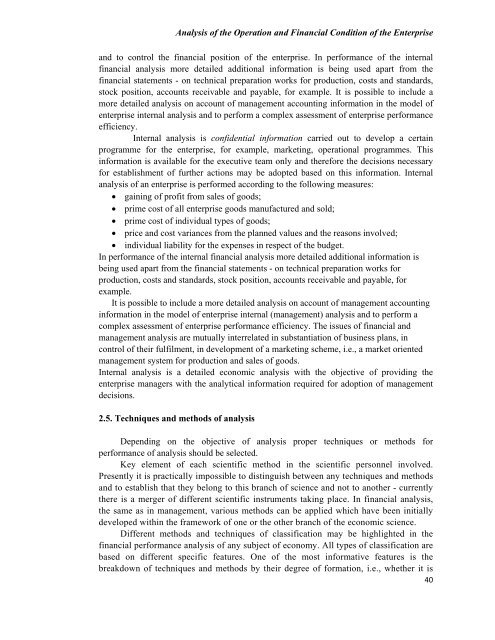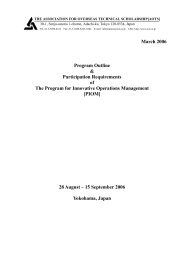Analysis of the Operation and Financial Condition of the Enterprise
Analysis of the Operation and Financial Condition of the Enterprise
Analysis of the Operation and Financial Condition of the Enterprise
Create successful ePaper yourself
Turn your PDF publications into a flip-book with our unique Google optimized e-Paper software.
<strong>Analysis</strong> <strong>of</strong> <strong>the</strong> <strong>Operation</strong> <strong>and</strong> <strong>Financial</strong> <strong>Condition</strong> <strong>of</strong> <strong>the</strong> <strong>Enterprise</strong><strong>and</strong> to control <strong>the</strong> financial position <strong>of</strong> <strong>the</strong> enterprise. In performance <strong>of</strong> <strong>the</strong> internalfinancial analysis more detailed additional information is being used apart from <strong>the</strong>financial statements - on technical preparation works for production, costs <strong>and</strong> st<strong>and</strong>ards,stock position, accounts receivable <strong>and</strong> payable, for example. It is possible to include amore detailed analysis on account <strong>of</strong> management accounting information in <strong>the</strong> model <strong>of</strong>enterprise internal analysis <strong>and</strong> to perform a complex assessment <strong>of</strong> enterprise performanceefficiency.Internal analysis is confidential information carried out to develop a certainprogramme for <strong>the</strong> enterprise, for example, marketing, operational programmes. Thisinformation is available for <strong>the</strong> executive team only <strong>and</strong> <strong>the</strong>refore <strong>the</strong> decisions necessaryfor establishment <strong>of</strong> fur<strong>the</strong>r actions may be adopted based on this information. Internalanalysis <strong>of</strong> an enterprise is performed according to <strong>the</strong> following measures: gaining <strong>of</strong> pr<strong>of</strong>it from sales <strong>of</strong> goods; prime cost <strong>of</strong> all enterprise goods manufactured <strong>and</strong> sold; prime cost <strong>of</strong> individual types <strong>of</strong> goods; price <strong>and</strong> cost variances from <strong>the</strong> planned values <strong>and</strong> <strong>the</strong> reasons involved; individual liability for <strong>the</strong> expenses in respect <strong>of</strong> <strong>the</strong> budget.In performance <strong>of</strong> <strong>the</strong> internal financial analysis more detailed additional information isbeing used apart from <strong>the</strong> financial statements - on technical preparation works forproduction, costs <strong>and</strong> st<strong>and</strong>ards, stock position, accounts receivable <strong>and</strong> payable, forexample.It is possible to include a more detailed analysis on account <strong>of</strong> management accountinginformation in <strong>the</strong> model <strong>of</strong> enterprise internal (management) analysis <strong>and</strong> to perform acomplex assessment <strong>of</strong> enterprise performance efficiency. The issues <strong>of</strong> financial <strong>and</strong>management analysis are mutually interrelated in substantiation <strong>of</strong> business plans, incontrol <strong>of</strong> <strong>the</strong>ir fulfilment, in development <strong>of</strong> a marketing scheme, i.e., a market orientedmanagement system for production <strong>and</strong> sales <strong>of</strong> goods.Internal analysis is a detailed economic analysis with <strong>the</strong> objective <strong>of</strong> providing <strong>the</strong>enterprise managers with <strong>the</strong> analytical information required for adoption <strong>of</strong> managementdecisions.2.5. Techniques <strong>and</strong> methods <strong>of</strong> analysisDepending on <strong>the</strong> objective <strong>of</strong> analysis proper techniques or methods forperformance <strong>of</strong> analysis should be selected.Key element <strong>of</strong> each scientific method in <strong>the</strong> scientific personnel involved.Presently it is practically impossible to distinguish between any techniques <strong>and</strong> methods<strong>and</strong> to establish that <strong>the</strong>y belong to this branch <strong>of</strong> science <strong>and</strong> not to ano<strong>the</strong>r - currently<strong>the</strong>re is a merger <strong>of</strong> different scientific instruments taking place. In financial analysis,<strong>the</strong> same as in management, various methods can be applied which have been initiallydeveloped within <strong>the</strong> framework <strong>of</strong> one or <strong>the</strong> o<strong>the</strong>r branch <strong>of</strong> <strong>the</strong> economic science.Different methods <strong>and</strong> techniques <strong>of</strong> classification may be highlighted in <strong>the</strong>financial performance analysis <strong>of</strong> any subject <strong>of</strong> economy. All types <strong>of</strong> classification arebased on different specific features. One <strong>of</strong> <strong>the</strong> most informative features is <strong>the</strong>breakdown <strong>of</strong> techniques <strong>and</strong> methods by <strong>the</strong>ir degree <strong>of</strong> formation, i.e., whe<strong>the</strong>r it is40
















